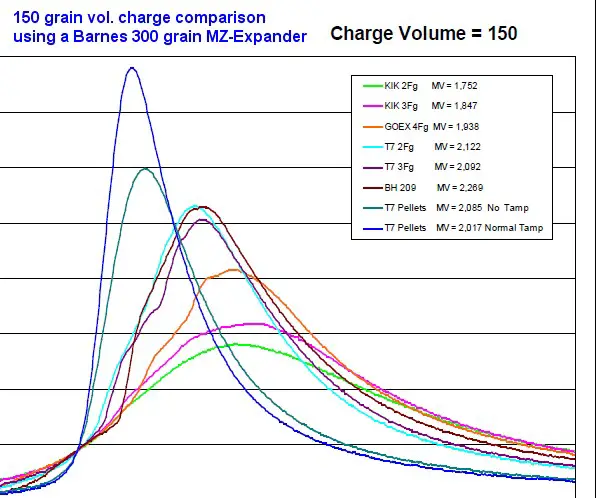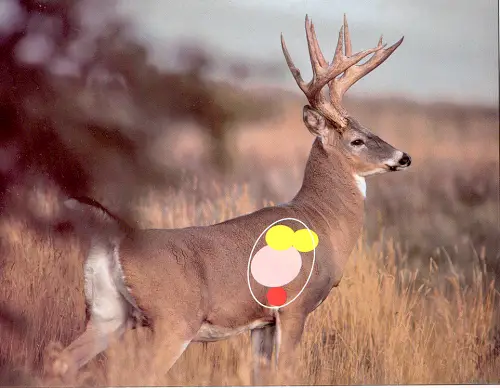


Muzzleloader Differences in Point Blank Range
An
easy way to hunt as championed by Jack O'Connor and an ethical way to
hunt is “point blank range” hunting. It is also an easy, common-sense
way to compare the effective range of rifles and loads. For deer hunting,
a “6 inch maximum point blank range” is used. It means the trajectory
of the bullet is never more than three inches high or low all the way
to the target. It works superbly well, as the kill zone of a deer is 8-10
inches. In the case of elk or moose, you have a much larger zone to work
with.
Muzzleloaders, assuming good shot placement, are devastating on big game. Tony Knight demonstrates the elk-flattening performance of the Knight .52 below. For the record, Tony was using three T7 pellets and a 375 grain Barnes MZ-Expander. The exterior ballistics follow, muzzle velocity is 1938 fps average.

Reference 20 ga. or 12 ga. 3 inch saboted slug, 22 in. barrel, 1750 fps (1900 fps on box), has a MPBR of 156 yards.
A 1700 fps Hornady .452 diameter 250 grain XTP has a MPBR
of 153 yards.
At 2000 fps, the same 250 grain XTP has a MPBR of 174 yards.
At 2250 fps, a Hornady .452 in. 250 grain SST has a MPBR of 206 yards (three T7 pellets, T/C Omega).
A 250 grain Barnes T-EZ at 1700 fps has a MPBR of 159
yards.
At 2000 fps, the 250 Barnes T-EZ has a MPBR of 184 yards.
At 2350 fps, the 250 Barnes T-EZ has a MPBR of 211 yards. (Note: this
is the Remington 700 Ultimate Factory Load)
A 275 grain Barnes XPB 275 (460 S & W bullet) at 2000
fps has a MPBR of 187 yards.
At 2200 fps, the Barnes XPB 275 has a MPBR of 203 yards.
A 290 grain Barnes T-EZ at 1700 fps has a MPBR of 163
yards.
At 2000 fps, the 290 grain Barnes T-EZ has a MPBR of 188 yards.
At 2125 fps, the 290 grain Barnes T-EZ has a MPBR of 198 yards. (135
gr. Volume Blackhorn 209)
A 300 grain Barnes Original .458 Semi-Spitzer Soft Point
has a MPBR of 194 yards.
At 2125 fps, the Barnes Original .458 Semi-Spitzer Soft Point has a MPBR
of 204 yards.
At 2262 fps, the Barnes Original .458 SS-SP has a MPBR of 217 yards.
(150 gr. Volume Blackhorn 209)
A Parker 300 grain Ballistic Extreme at 1700 fps has a
MPBR of 166 yards.
At 2000 fps, the 300 grain Parker Ballistic Extreme has a MPBR of 193
yards.
A Parker 300 grain Match Hunter at 2000 fps has a MPBR
of 198 yards.
At 2125 fps, the 300 grain Match Hunter has a MPBR of 210 yards. (135
gr. Volume Blackhorn 209)
At 2350 fps, the 300 grain Parker Match Hunter has a MPBR of 233 yards.
Warning: 150 grains by volume Blackhorn 209 averages 2269 fps with a 300 grain saboted projectile. This is an OVERLOAD in any current production muzzleloader except for the Remington Model 700 Ultimate. Max. load per Western Powders is 120 grains by volume. Max. load per Hodgdon for T7 is 100 grains loose powder, 120 grains for pellets.

This should make a couple of points clear to anyone. Muzzleloaders are dramatically better than slug guns, meaning shotguns with rifled barrels. However, muzzleloaders are not remotely the same as center-fire rifles. Note that a Hornady .30-30 Win 160 grain leveREVOLUTION FTX cartridge has a MPBR of 234 yards. No production muzzleloader has had a trajectory as flat as this .30-30 round.
The classic .270 Winchester, introduced in 1925, does not have a “magnum” moniker. Yet, with 130 grain Hornady Superformance Interbond cartridges, it is a 309 yard MPBR rifle. That is the load I used just last year right at 300 yards on a fat old Blue Wildebeest.
It is certainly fair to say that slug guns have improved, muzzleloaders have improved, as have centerfire rifles. However, the notion that they are somehow "the same" or even similar is only the concoction of intoxicated marketing departments. No one with any field experience would buy into that nonsense.
However, muzzleloading has put more big game in my freezers than any other firearm. The better muzzleloaders have come a very long way in terms of safety, reliability, accuracy, and ease of use. We should all be grateful for that, for nothing competes with one clean shot and one instant harvest. Muzzleloading demands that, and now we have better tools for the job.

Top of the back to bottom of the brisket estimates for game animals via Jack O'Connor.
Pronghorn
antelope = 14"-15"
Small deer = 14"-15"
Medium size deer = 17"-18"
Large deer = 18"-20"
North American wild sheep = 20"-22"
Mountain goat = 22"-24"
Caribou = 24"-26"
Elk = 24"-26"
Moose = 30"-36"
Approximate critical circle diameters that are heart-lung area:
Pronghorn
antelope = 8.5"-9"
Small deer = 8.5"-9"
Medium size deer = 10"-11"
Large deer = 11"-12"
North American wild sheep = 12"-13"
Mountain goat = 13"-14.5"
Caribou = 14.5"-15.5"
Elk = 14.5"-15.5"
Moose = 18"-21.5"
NOTE:
At 250 - 260 yards, holding on the back of a medium - large deer with the 300 grain Parker Match Hunter @ 2125 fps means about 8.71 - 10.42 inches of drop below line of sight, dropping to the center of the kill zone. No "Kentucky Windage," knob-clicking, or hold-over reticle required. For a bit more range, we can tweak our Point Blank Range with an 8 inch kill zone.
Using the same load, as an "8 inch kill" MPBR, with a 200 yard zero, the PBR is now 234 yards with a perfect center of the body hold. Less room for aiming error, though, so that little struggle to net just 14 yards isn't worth it, by most standards.
For more on "Maximum Point Blank Range Hunting," see: http://randywakeman.com/What-isMaximumPointBlankRangeHunting.htm .
Copyright 2014 by Randy Wakeman. All Rights Reserved.



